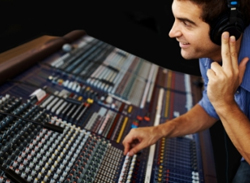
Hit It
Here is how I like to track a vocal session.
First, I’ve taken time to choose the correct mic, preamp, compressor, incense, tea, lighting and dialed in a headphone mix. (Note: It’s very important to have a great headphone mix. It will result in less fatigue and frustration from the performer.)
Next, I like record a couple of full passes before we even think about punches. Let the performer get into the vibe of the song.
After 3-4 takes, stop. Take a few second break for water and then listen. Before we listen, I make sure we both have a pencil and paper. As we review each take, we write notes of what we liked or didn’t.
Listening to 8 takes in a row is overwhelming! It’s too much to digest. Plus, I’ve heard that if you listen to 9 takes in a row it could cause bowel irritation. Ok, I made that up. But, if I have to listen to 9 takes in a row of the 3rd part background vocal I’m going to be calling my friend Johnny Walker Red… And we’re gonna have a loooong chat, if ya know what I mean.
When the last take has completed playing, we compare notes and see if we have a comp. In the event the overall performance is not there, we repeat the 3-4 take run, break, then listen, take notes, comp.
If we just need a few bits, we comp the the take and punch in where needed. Notice I mention we comp BEFORE we punch!
Performance Drift
There is something I like to call “Performance Drift.” This is when the artists’ performance changes dramatically from the first take to the last. Volume, expression, and enthusiasm may have shifted during flight. Limiting tracking to 3-4 takes at a clip prevents performance drift as there will be breaks and reviewing that keeps it fresh.
Hash It Out
Don’t use recording as your practice. Need to review something because it’s not right? Stop playback and run it. Work it out. Be prepared and ready when the red light is on.
Don’t have the mindset of “I’ll fix it later.” The performance will always suffer. Even though we know comping and punching is an option, it’s good to pretend that it is not. A coherent take will always sound better.
Binary Composting
Don’t be a take-hoarder. Go ahead and delete! Don’t be afraid. Why live in the past, when you can be in the present? Last take only so-so? DELETE.
It’s also good idea to delete all unused audio from your sessions. It’s no use carrying around that baggage. No reason to have 20 gigs of audio that you’re not using. A bloated session is harder to backup or track down a file if need be. Plus, it takes longer to load.
If you’re not using it, send it off to greener pastures (aka your trash bin). Think of it as composting for 1’s and 0’s. Dare I say binary composting?!?!
Adios
Before I tell the musician a session is over, I make sure I have a comp I can live with. It should include all crossfades and edits cleaned. I want to know I have the part and what it sounds like. Leave nothing to the imagination…except which island your summer home will be on after your single blows up.
Mark Marshall is a producer, songwriter, session musician and instructor based in NYC.
Be sure to visit The Pro Audio Files for more great recording content. To comment or ask questions about this article, go here.
